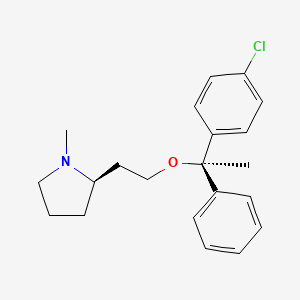Attribution Statement: LactMed is a registered trademark of the U.S. Department of Health and Human Services.
NCBI Bookshelf. A service of the National Library of Medicine, National Institutes of Health.
Drugs and Lactation Database (LactMed®) [Internet]. Bethesda (MD): National Institute of Child Health and Human Development; 2006-.
CASRN: 15686-51-8

Drug Levels and Effects
Summary of Use during Lactation
Small occasional doses of clemastine are acceptable during breastfeeding. Larger doses or more prolonged use may cause drowsiness and other effects in the infant or decrease the milk supply, particularly in combination with a sympathomimetic such as pseudoephedrine or before lactation is well established. Single bedtime doses after the last feeding of the day may be adequate for many women and will minimize any effects of the drug. The nonsedating antihistamines are preferred alternatives.
Drug Levels
Maternal Levels. The milk clemastine level was 5 to 10 mcg/L 20 hours after the last dose in a 1 mg twice daily regimen in one woman. A simultaneous serum level was 20 mcg/L.[1]
Infant Levels. Relevant published information was not found as of the revision date.
Effects in Breastfed Infants
A 10-week-old breastfed infant whose mother was taking clemastine, phenytoin and carbamazepine was drowsy, refused to feed, was irritable, and had high-pitched crying.[1] These side effects were possibly caused by clemastine in breastmilk, but the other drugs could also have contributed.
In one telephone follow-up study, mothers reported irritability and colicky symptoms 10% of infants exposed to various antihistamines and drowsiness was reported in 1.6% of infants. None of the reactions required medical attention.[2]
Effects on Lactation and Breastmilk
Antihistamines in relatively high doses given by injection can decrease basal serum prolactin in nonlactating women and in early postpartum women.[3,4] However, suckling-induced prolactin secretion is not affected by antihistamine pretreatment of postpartum mothers.[3] Whether lower oral doses of antihistamines have the same effect on serum prolactin or whether the effects on prolactin have any consequences on breastfeeding success have not been studied. The prolactin level in a mother with established lactation may not affect her ability to breastfeed.
Alternate Drugs to Consider
References
- 1.
- Kok TH, Taitz LS, Bennett MJ, et al. Drowsiness due to clemastine transmitted in breast milk. Lancet 1982;319:914-5. [PubMed: 6122135]
- 2.
- Ito S, Blajchman A, Stephenson M, et al. Prospective follow-up of adverse reactions in breast-fed infants exposed to maternal medication. Am J Obstet Gynecol 1993;168:1393-9. [PubMed: 8498418]
- 3.
- Messinis IE, Souvatzoglou A, Fais N, et al. Histamine H1 receptor participation in the control of prolactin secretion in postpartum. J Endocrinol Invest 1985;8:143-6. [PubMed: 3928731]
- 4.
- Pontiroli AE, De Castro e Silva E, Mazzoleni F, et al. The effect of histamine and H1 and H2 receptors on prolactin and luteinizing hormone release in humans: Sex differences and the role of stress. J Clin Endocrinol Metab 1981;52:924-8. [PubMed: 7228996]
Substance Identification
Substance Name
Clemastine
CAS Registry Number
15686-51-8
Drug Class
Breast Feeding
Lactation
Milk, Human
Antihistamines
Disclaimer: Information presented in this database is not meant as a substitute for professional judgment. You should consult your healthcare provider for breastfeeding advice related to your particular situation. The U.S. government does not warrant or assume any liability or responsibility for the accuracy or completeness of the information on this Site.
- User and Medical Advice Disclaimer
- Drugs and Lactation Database (LactMed) - Record Format
- LactMed - Database Creation and Peer Review Process
- Fact Sheet. Drugs and Lactation Database (LactMed)
- Drugs and Lactation Database (LactMed) - Glossary
- LactMed Selected References
- Drugs and Lactation Database (LactMed) - About Dietary Supplements
- Breastfeeding Links
- PubChem SubstanceRelated PubChem Substances
- PubMedLinks to PubMed
- Review Chlorpheniramine.[Drugs and Lactation Database (...]Review Chlorpheniramine.. Drugs and Lactation Database (LactMed®). 2006
- Review Dexbrompheniramine.[Drugs and Lactation Database (...]Review Dexbrompheniramine.. Drugs and Lactation Database (LactMed®). 2006
- Review Brompheniramine.[Drugs and Lactation Database (...]Review Brompheniramine.. Drugs and Lactation Database (LactMed®). 2006
- Review Dexchlorpheniramine.[Drugs and Lactation Database (...]Review Dexchlorpheniramine.. Drugs and Lactation Database (LactMed®). 2006
- Review Azatadine.[Drugs and Lactation Database (...]Review Azatadine.. Drugs and Lactation Database (LactMed®). 2006
- Clemastine - Drugs and Lactation Database (LactMed®)Clemastine - Drugs and Lactation Database (LactMed®)
- CCDC74B coiled-coil domain containing 74B [Homo sapiens]CCDC74B coiled-coil domain containing 74B [Homo sapiens]Gene ID:91409Gene
Your browsing activity is empty.
Activity recording is turned off.
See more...
